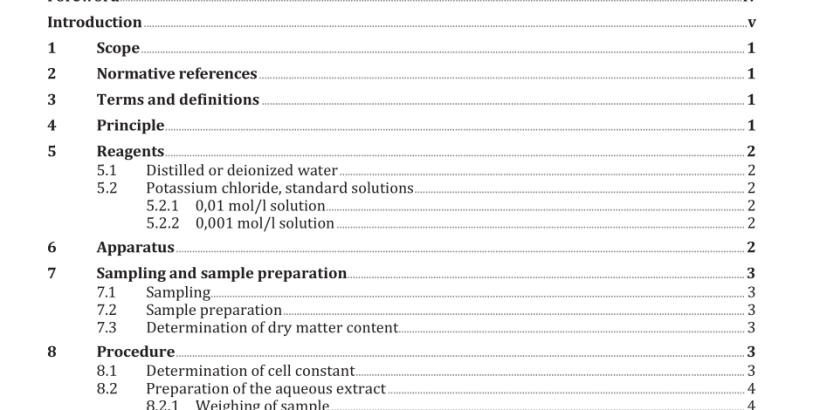ISO 6587:2021 pdf download – Paper, board and pulps — Determination of conductivity of aqueous extracts.
1 Scope This document specifies a method for the determination of the conductivity of aqueous extracts of paper, board or pulp, these extracts having been prepared by a hot or cold method. The method is applicable to all kinds of paper, board and pulps, except for papers used for electrical purposes. For high purity papers used for electrical purposes, see method given in EN 60554-2. 2 Normative references The following documents are referred to in the text in such a way that some or all of their content constitutes requirements of this document. For dated references, only the edition cited applies. For undated references, the latest edition of the referenced document (including any amendments) applies. ISO 186, Paper and board — Sampling to determine average quality ISO 287, Paper and board — Determination of moisture content of a lot — Oven-drying method ISO 638-1, Paper, board, pulps and cellulosic nanomaterials — Determination of dry matter content by oven-drying method — Part 1: Materials in solid form ISO 7213, Pulps — Sampling for testing 3 Terms and definitions For the purposes of this document, the following terms and definitions apply. ISO and IEC maintain terminology databases for use in standardization at the following addresses: — ISO Online browsing platform: available at https://www.iso .org/obp — IEC Electropedia: available at https://www.electropedia .org/
5 Reagents 5.1 Distilled or deionized water Distilled or deionized water shall be used throughout the test. The conductivity of the water shall not exceed 0,2 mS/m after boiling and cooling as specified in 8.2.2 . NOTE Usually, both distillation and deionization are required. Unless great care is exercised when distilling, and with the materials employed in the condenser and subsequent surfaces with which the condensed vapour would possibly come in contact, the distillate can fail to reach the required level of conductivity. When it is not possible to obtain water of the specified purity, water with a higher conductivity may be used, but the conductivity of the water used should be stated in the test report. 5.2 Potassium chloride, standard solutions Use potassium chloride (KCl) of recognized analytical reagent grade, powdered, or fine crystals. Dry for 2 h at 105 °C ± 2 °C and immediately prepare the following two solutions. 5.2.1 0,01 mol/l solution Dissolve 0,745 g of the potassium chloride in water having a conductivity not greater than 0,2 mS/m, and dilute to 1 000 ml. 5.2.2 0,001 mol/l solution Dilute 100 ml of the 0,01 mol/l solution ( 5.2.1) to 1 000 ml. Store the solutions in waxed glass bottles with ground glass stoppers. The conductivity values, in millisiemens per meter, of the two solutions, are given in Table 1.
8.2 Preparation of the aqueous extract 8.2.1 Weighing of sample Weigh 2 g ± 0,002 g (oven-dry basis) of the sample ( 7.2) into a flask of suitable size (6.1) that has been carefully washed with boiling water (5.1). 8.2.2 Hot extraction method With the aid of a pipette, measure 100 ml of water (5.1) into a separate flask (6.1). Attach the reflux condenser (see 6.1) and heat the water to almost boiling. Remove the condenser and add the water to the flask containing the sample (8.2.1). Replace the reflux condenser then boil gently for 1 h on the electric heater (6.2). Cool rapidly, with the condenser still fitted, to about 25 °C. Let the fibres settle and then decant the extract. Prepare the extract in duplicate. Using the constant temperature bath (6.4), adjust the temperature of the extract to 25 °C ± 0,5 °C and maintain that temperature throughout the test. 8.2.3 Cold extraction method With the aid of a pipette, measure 100 ml of water ( 5.1) into the flask containing the sample (8.2.1). Seal the flask with a ground glass stopper and leave to stand at room temperature (20 °C to 25 °C) for 1 h. Shake the flask at least once during this time. Decant the extract. Prepare the extract in duplicate. Using the constant temperature bath (6.4), adjust the temperature of the extract to 25 °C ± 0,5 °C and maintain that temperature throughout the test. 8.3 Determination of conductivity Rinse the measuring cell (see 6.3) carefully, several times with the water (5.1), and then twice more with the extract from 8.2.2 or 8.2.3 . Measure the conductance or resistance with fresh portions of the extract until a constant value is obtained. Repeat the determination with the duplicate extract.
